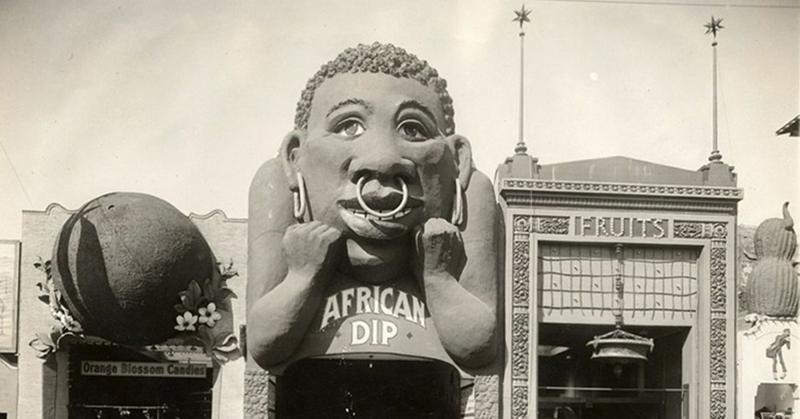Disturbing Things People Did At Carnivals In The Early 20th Century
By | July 9, 2020

At the onset of the 20th century, traveling carnivals grew out of the World's Fair and became a beloved pastime for families seeking a fun night out that wouldn't leave them broke. Unfortunately, their enjoyable evening walking the midway was a nightmare for the people working the fair and the animals who had no choice in the matter. From freak shows to racist "games," there was no end to the cruelty that occurred at carnivals in the early 20th century.
Racist Games
The most egregious and horrific carnival attraction was known by a few names, and "African Dodger" was the least racist. Often advertised as "Hit The ------ Baby," this "game" called for a black employee to stick his head through a canvas curtain and try to dodge the objects patrons paid to throw at him, which could be anything from eggs to baseballs to rocks. You might recognize this as a great way to get a concussion at best and a dreadful case of death at worst. A man named William White from Hanover, Pennsylvania died in 1908 after a group of baseball players took turns chucking balls at his head until he couldn't take it anymore.
At some point in the early 20th century, carnival owners decided it was bad business to provide "money for murder" transactions, so they created the "African Dip," in which a black employee perched above a tank built to look like a cauldron and customers paid to throw baseballs at a mechanism that dropped the man into the tank instead of his head. Over time, the racist overtones were stripped away from this midway game. Today, it's simply known as the dunk tank. It's likely that the games of duck pond and ring toss were inspired by African Dodger, too, so there's pretty much no avoiding the midway's racist past at any given carnival.

The Allure Of The "Far East"
Carnival barons were equal-opportunity racists: One of more damaging aspects of carnivals were their advertisements promising information, artifacts, or people from the "Far East." Through the '50s, carnivals presented the Asian people as either snake charmers and gurus or savages displayed alongside animals and other curiosities from faraway places.

Animal Cruelty
Exotic animals from lions to elephants to monkeys have always played a major part in carnival life, but while activist groups ensure their humane treatment today, nobody realized the depths of their plight in the early 20th century. And those were some deep depths: Even through the '50s and '60s, animals were carted around the country in small cages, some of them were shipped across the sea, and they were usually starved and beaten to keep them docile.
Horses got it particularly bad. Not every carnival in the '20s and '30s had horse racing, but those that did really made sure that it wasn't safe for the animals. The races usually featured two-wheeled, one-horse carriages that carried one rider known as a "sulky" who faced off against another sulky with a horse cart. They rode on uneven rode, took turns that weren't made for them, and generally mistreated the horses. Another popular attraction was the "diving horse," dreamed up by William "Doc" Carver, who was allegedly inspired by an event in 1881 when he was crossing a bridge in Nebraska that collapsed. According to Carver's story, his horse either fell or dove into the water, so he took it upon himself to train horses for diving. He was not good at it: In the 1920s, countless horses were harmed by this cruel act. Even after the act was phased out, it was the focal point of Disney's 1991 film Wild Hearts Can't Be Broken.

Freak Shows
By the 1990s, freak shows had come into their own as a celebration of the unusual, but in the '20s and '30s, freak shows were just an excuse to gawk at another human's otherness. Although some performers felt these shows were an opportunity to provide value to society, many of them simply had no other means to support themselves, and the people who profited off the shows had no qualms exploiting that desperation. People with misshapen heads were described as "missing links," and those with missing limbs were looked at as animals.
The "geek" act was a particularly debasing part of the show. That was the name for the person who began the show by chasing live chickens around the ring before finally grabbing one of the chickens, biting its head off, and swallowing it whole. More often than not, geeks were alcoholics or drug addicts who were paid in their poison of choice.

Luther Dennis's Hot Air Balloon
Not every disturbing thing that went down at carnivals in the early 1900s happened at every midway. Case in point: Luther Dennis's hot air balloon. Dennis's whole thing was to get in his balloon, heat the air as quickly as possible so he could ascend into the sky while hanging onto it, then parachute to the ground. There were four sand bags in the balloon, so when he jumped away, the balloon would quickly land. This didn't go as planned at least once. During one show, he forgot to add the sand bags, so when he parachuted from the balloon, it continued to drag across the countryside. It finally landed in a crop of trees.

Fight Clubs
Many carnivals in the early 20th century offered boxing or wrestling matches to give the fellas something to watch. More often than not, the matches were staged to keep marks spending their money, but sometimes, locals were allowed to get in the ring and do some fighting of their own. No one expected any part of this to take a Brad Pitty turn, but here we are.

